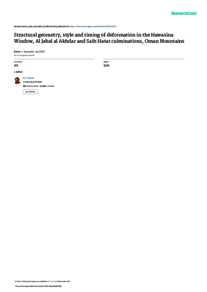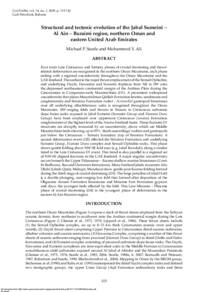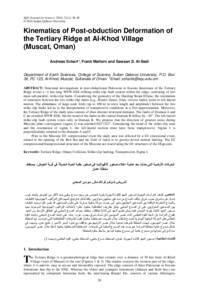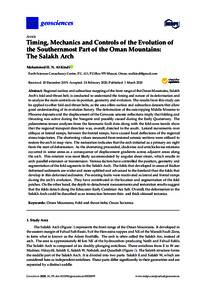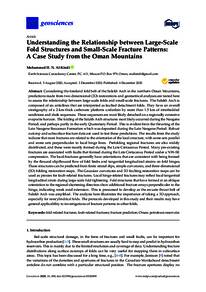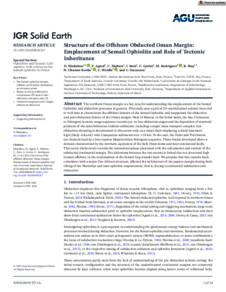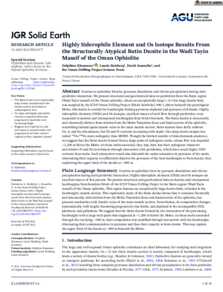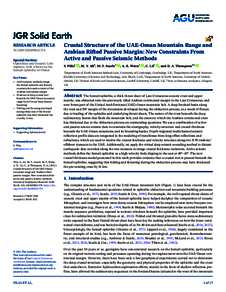وثيقة
Structural geometry, style and timing of deformation in the Hawasina window, Al Jabal al Akhdar and Saih Hatat culminations, Oman mountains.
المعرف
DOI: 10.2113/geoarabia120299
المصدر
GeoArabia. v. 12, 2, p. 99-130
الدولة
Bahrain.
مكان النشر
Manama
الناشر
Gulf Petrolink.
ميلادي
2004-04-01
اللغة
الأنجليزية
الموضوع
الملخص الإنجليزي
The Al Jabal al Akhdar and Saih Hatat culminations in the central Oman Mountains expose the complete mid-Permian to Late Cretaceous (Cenomanian) passive shelf and margin carbonate sequence beneath the allochtonous slope (Sumeini Group), basin (Hawasina complex), distal ocean-trench (Haybi complex) facies rocks, and the Semail ophiolite thrust sheets that were emplaced from NE to SW during the Late Cretaceous. Reconstruction of the pre-thrust sequences shows that time-equivalent rocks occur in successively stacked thrust sheets from shelf to slope to basin. The Al Jabal al Akhdar structure is a 60 km wavelength anticline plunging to the northwest beneath the Hawasina Window and with a fold axis that curves from WNW-ESE (Jabal Shams) to NNE-SSW (Jabal Nakhl). The structure shows little internal deformation except for minor intra-formational thrust duplexing within the Cretaceous shelf stratigraphy along the northern margin. The upper structural boundaries around the flanks of the shelf carbonate culminations have been re-activated as late stage normal faults. The Semail thrust formed a passive roof fault during late-stage culmination of al Al Jabal al Akhdar such that the ophiolite rests directly on Wasia Formation top-shelf with the entire Sumeini, Hawasina and Haybi thrust sheets displaced around the margins. NE-directed backthrusting and intense folding in the northern part of the Hawasina Window affects all allochtonous units and is related to a steep ramp in the Late Cretaceous shelf margin at depth. The Saih Hatat culmination is another 40 km half-wavelength anticline in the central Oman Mountains, but shows extreme deformation in the form of recumbent folds, sheath folds with NNE-trending axes and thrusting along the northern margin. High-pressure carpholite, blueschist and eclogite facies rocks are exposed at successively deeper structural levels, separated by high-strain normal sense shear zones. There is no evidence for a separate 'North Muscat microplate' or an intra-continental subduction zone, as previously proposed; all high-pressure units can be restored to show their pre-deformation palaeographic positions along the northern margin of the Arabian Plate. Both Al Jabal al Akhdar and Saih Hatat are Late Cretaceous culminations, folded after obduction of the Hawasina, Haybi and Semail ophiolite thrust sheets from northeast to southwest during the period Turonian to Campanian-Lower Maastrichtian. Maximum compressive stress along the central Oman Mountains was oriented NE-SW, parallel to the ophiolite emplacement direction, but a second compressive stress axis was oriented WNW-ESE, either concurrently or slightly later in time, resulting in a dome and basin structural geometry. The biaxial fracture pattern in the foreland, southwest of the Oman Mountains could be explained as a result of the WNW-directed emplacement of the Masirah ophiolite belt and Batain mélange during the Campanian-early Palaeocene. Both Al Jabal al Akhdar and Saih Hatat were positive topographic features at the end of the Cretaceous with Upper Maastrichtian and Palaeogene sediments onlapping both flanks. In Jabal Abiad, these Palaeogene sediments have been uplifted by at least 2 km since the Late Miocene-Early Oligocene associated with minor NNE-SSW compression. Tertiary shortening, folding and thrusting increases to the north in the Musandam peninsula where the first effects of the Arabian Plate-Eurasian Plate (Zagros belt) continent-continent collision are seen.
ISSN
1025-6059
قالب العنصر
مقالات الدوريات

